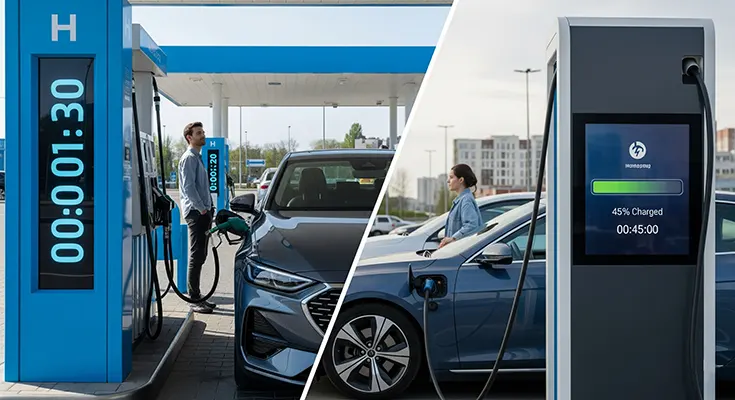When it comes to the future of transportation, the debate between hydrogen fuel cell vehicles (FCEVs) and battery electric vehicles (BEVs) is often framed around a single, critical factor: refueling time. While BEVs require a patient wait at a charging station, a hydrogen-powered vehicle can be back on the road in minutes. This significant difference is not a matter of luck but is rooted in the fundamental physics and engineering of each technology.
The core reason for this speed advantage is that FCEVs are designed to be “fueled,” while BEVs are “charged.”
The Physics of Fueling vs. Charging
Hydrogen Fueling: The High-Pressure Flow
Hydrogen fuel cell vehicles store hydrogen gas in high-pressure tanks, typically at 700 bar (10,000 psi). The refueling process is essentially a high-tech version of filling a gas tank:
- Pressurized Transfer: A pump at the hydrogen station compresses and cools the hydrogen gas.
- Dispensing: A specialized nozzle attaches to the vehicle’s receptacle, creating a sealed connection.
- Rapid Fill: The high-pressure hydrogen is transferred from the station’s storage tanks into the vehicle’s tank in a matter of minutes. The process is a direct transfer of a physical medium (the gas), which is a rapid operation. The speed is limited by the flow rate and the pressure difference between the station and the car’s tank.
The entire process, from connecting the nozzle to a full tank, can take as little as 3 to 5 minutes, a time frame that is directly comparable to filling a gasoline-powered car.
Electric Car Charging: The Slower Transfer of Energy
An electric vehicle, by contrast, relies on a different principle. It needs to transfer a large amount of electrical energy from an external source into its onboard battery.
- Power Conversion: The electricity from the grid needs to be converted and conditioned to a form that the battery can accept.
- Battery Management System: The vehicle’s battery management system (BMS) carefully controls the flow of electricity into the battery cells. The BMS regulates the charging process to prevent overheating, overcharging, and cell damage. This is a critical safety and longevity feature that inherently limits the speed of the charging process.
- Chemical and Thermal Limitations: The process of a battery absorbing and storing a large amount of energy is governed by chemical and thermal limitations. Pushing too much current into the battery too quickly generates significant heat and can degrade the battery’s performance and lifespan. As a result, the charge rate slows down as the battery fills up. This is why a “fast charge” typically takes 30 minutes to an hour to reach 80% capacity, and the final 20% takes much longer.
The Key Takeaways: Why Hydrogen Wins on Speed
- Physical Transfer vs. Chemical Process: Hydrogen refueling is a physical transfer of a compressed gas, which is inherently fast. EV charging is a chemical process that requires careful management and is limited by the battery’s ability to absorb energy safely.
- Energy Density: Hydrogen, as an energy carrier, offers a high energy density, allowing a small volume of compressed gas to hold enough energy for a long range. To achieve the same range, a BEV requires a very large and heavy battery, which takes a long time to fill with a significant amount of electricity.
- Scaling Up: While ultra-fast EV chargers are becoming more common, increasing their power output further puts a significant strain on the electrical grid. A hydrogen station, on the other hand, can be designed to store a large amount of hydrogen, allowing for a high volume of rapid refueling without the same localized grid impact (though the production of the hydrogen itself requires electricity).
The fundamental difference between FCEV refueling and BEV charging is the difference between a quick fluid transfer and a careful, chemical-based energy storage process. For drivers and commercial operators who require minimal downtime and the ability to get back on the road quickly, this speed advantage is a compelling argument for the role of hydrogen in the future of zero-emission transportation, particularly for long-haul and heavy-duty applications.

